Investigation of Performance Stability of a Nytrox Hybrid Rocket Propulsion System
Abstract
:1. Introduction
2. Research Methods
2.1. Combustion Chamber Design and Specification
2.2. Theoretical Models for the Mixture of Liquid Nitrous Oxide and Oxygen
2.2.1. Determination of the Filling Method of Nitrous Oxide
2.2.2. Estimation of the Solubility of O2 in Liquid/Gaseous N2O
2.3. Experimental Facility and Instrumentation
2.4. Experimental Configuration and Procedure
3. Results and Discussion
3.1. Analysis of Pure Nitrous Oxide HRE Hot-Fire Test Results
3.2. Analysis of Nytrox HRE Hot-Fire Test Results
4. Conclusions
Author Contributions
Funding
Data Availability Statement
Acknowledgments
Conflicts of Interest
References
- Wei, S.S.; Li, M.C.; Lai, A.; Chou, T.H.; Wu, J.S. A Review of Recent Developments in Hybrid Rocket Propulsion and Its Applications. Aerospace 2024, 11, 739. [Google Scholar] [CrossRef]
- Kelly, J.W.; Rogers, C.E.; Brierly, G.T.; Martin, J.C.; Murphy, M.G. Motivation for Air-Launch: Past, Present, and Future. In Proceedings of the AIAA SPACE and Astronautics Forum and Exposition, Orlando, FL, USA, 12–14 September 2017. [Google Scholar]
- Thicksten, Z.; Macklin, F.; Campbell, J. Handling Considerations of Nitrous Oxide in Hybrid Rocket. In Proceedings of the 44th AIAA/ASME/SAE/ASEE Joint Propulsion Conference and Exhibit, Hartford, CT, USA, 21–23 July 2008. [Google Scholar]
- Kobald, M.; Schmierer, C.; Fischer, U.; Tomilin, T.; Petrarolo, A.; Rehberger, M. The HyEnD Stern Hybrid Sounding Rocket Project. Prog. Propuls. Phys. 2019, 11, 25–64. [Google Scholar]
- Hybrid Engine Development. First Results of the N2ORTH Post Flight Analysis. Available online: https://hyend.de/index.php/2023/07/18/first-results-of-the-n2orth-post-flight-analysis/ (accessed on 8 September 2024).
- Zakirov, V.; Sweeting, M.; Lawrence, T.; Sellers, J. Nitrous Oxide as a Rocket Propellant. Acta Astronaut. 2001, 48, 353–362. [Google Scholar] [CrossRef]
- ESDU. Thermophysical Properties of Nitrous Oxide; ESDU: London, UK, 1991. [Google Scholar]
- Karabeyoglu, A. Mixtures of Nitrous Oxide and Oxygen (Nytrox) as Oxidizers for Rocket Propulsion Applications. In Proceedings of the 45th AIAA/ASME/SAE/ASEE Joint Propulsion Conference and Exhibit, Denver, CO, USA, 2–5 August 2009. [Google Scholar]
- Karabeyoglu, A. Nitrous Oxide and Oxygen Mixtures (Nytrox) as Oxidizers for Rocket Propulsion Applications. J. Propuls. Power 2014, 30, 696–706. [Google Scholar] [CrossRef]
- Whitmore, S.A.; Stoddard, R.L. Medical Grade N2O/O2 Mixtures as Inexpensive and Volumetrically Efficient Oxidizers for Small Spacecraft Hybrid Propulsion Systems. In Proceedings of the AIAA Propulsion and Energy 2019 Forum, Indianapolis, IN, USA, 19–22 August 2019. [Google Scholar]
- Whitmore, S.A. Nytrox as “Drop-in” Replacement for Gaseous Oxygen in SmallSat Hybrid Propulsion Systems. Aerospace 2020, 7, 43. [Google Scholar] [CrossRef]
- Whitmore, S.A.; Stoddard, R.L. N2O/O2 blends safe and volumetrically efficient oxidizers for small spacecraft hybrid propulsion. Aeronaut. Aerosp. Open Access J. 2019, 3, 171–196. [Google Scholar] [CrossRef]
- Whitmore, S.A.; Frischkorn, C.I. Analyzing and Reducing Ignition Latency of a Nytrox/ABS Hybrid Propulsion System. In Proceedings of the AIAA Propulsion and Energy 2020 Forum, Online, 24–28 August 2020. [Google Scholar]
- Beer, J.M.; Chigier, N.A. Combustion Aerodynamics; Applied Science Publishers: London, UK, 1972. [Google Scholar]
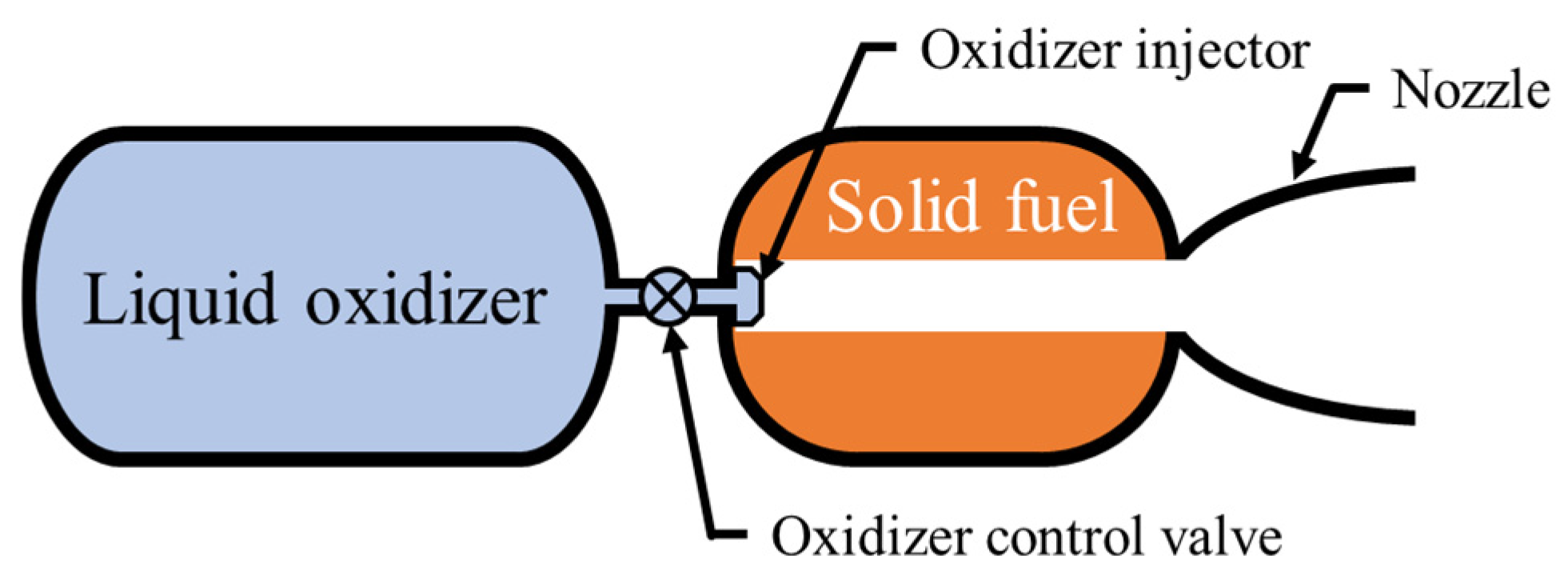
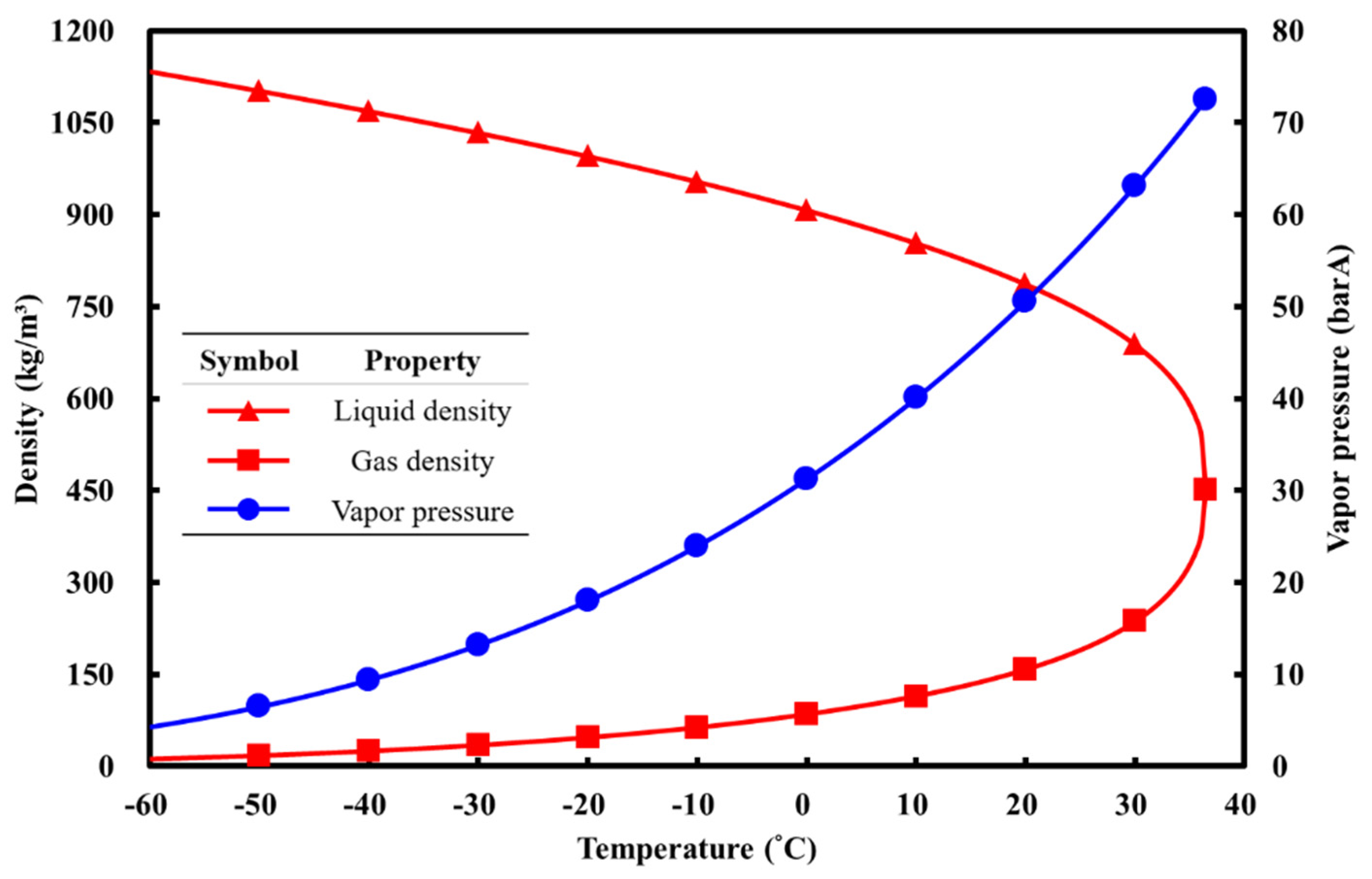



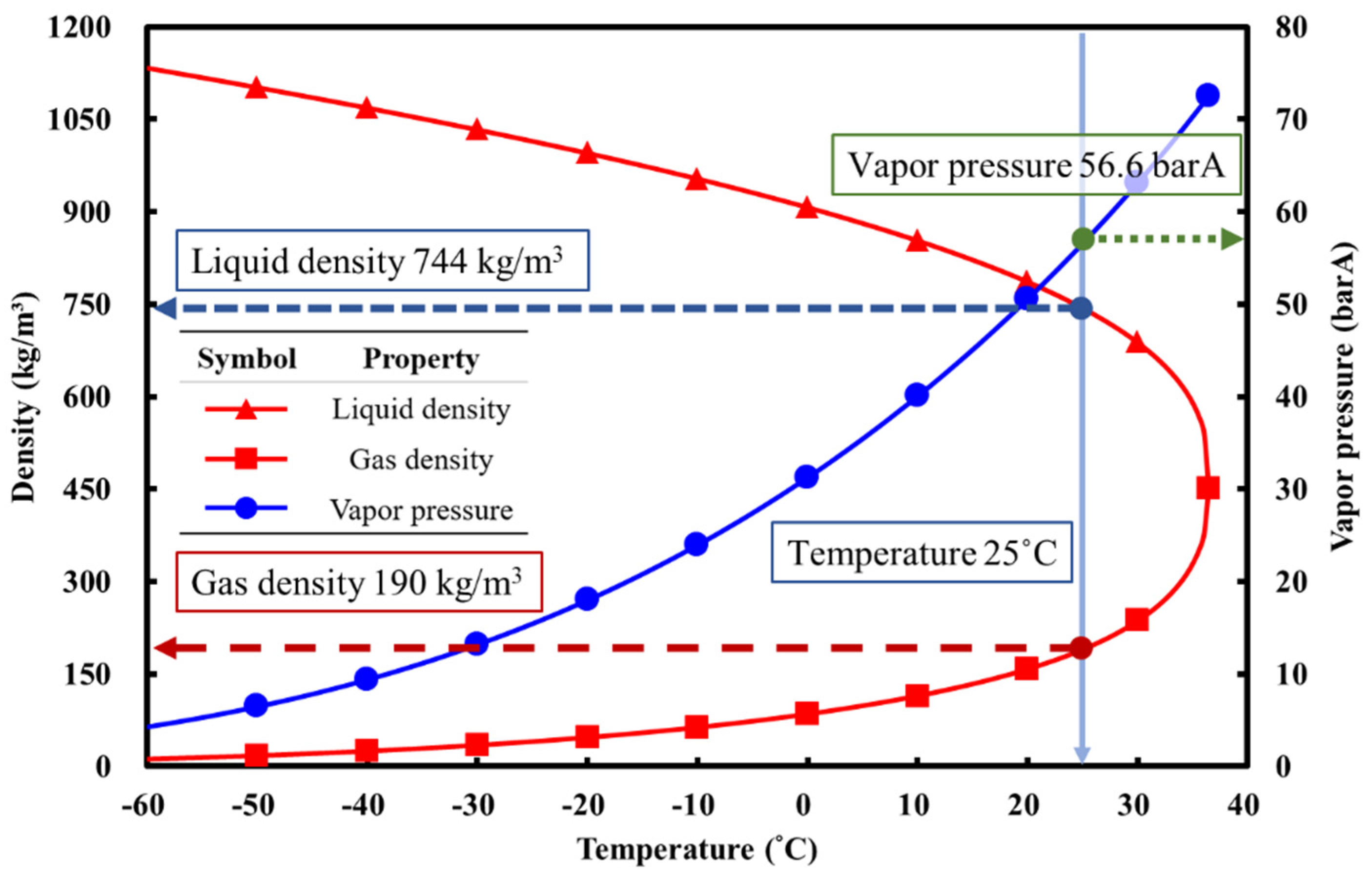
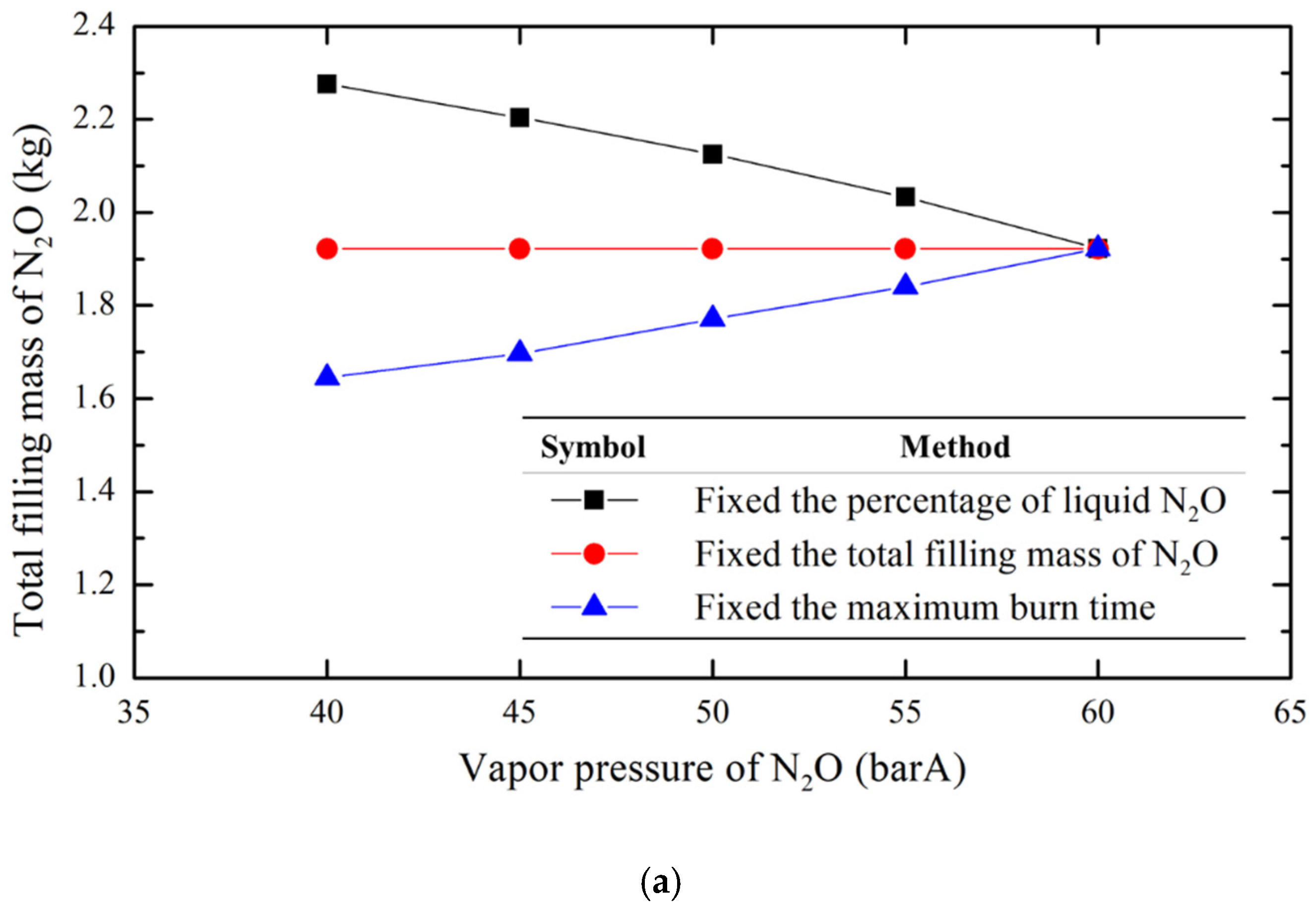


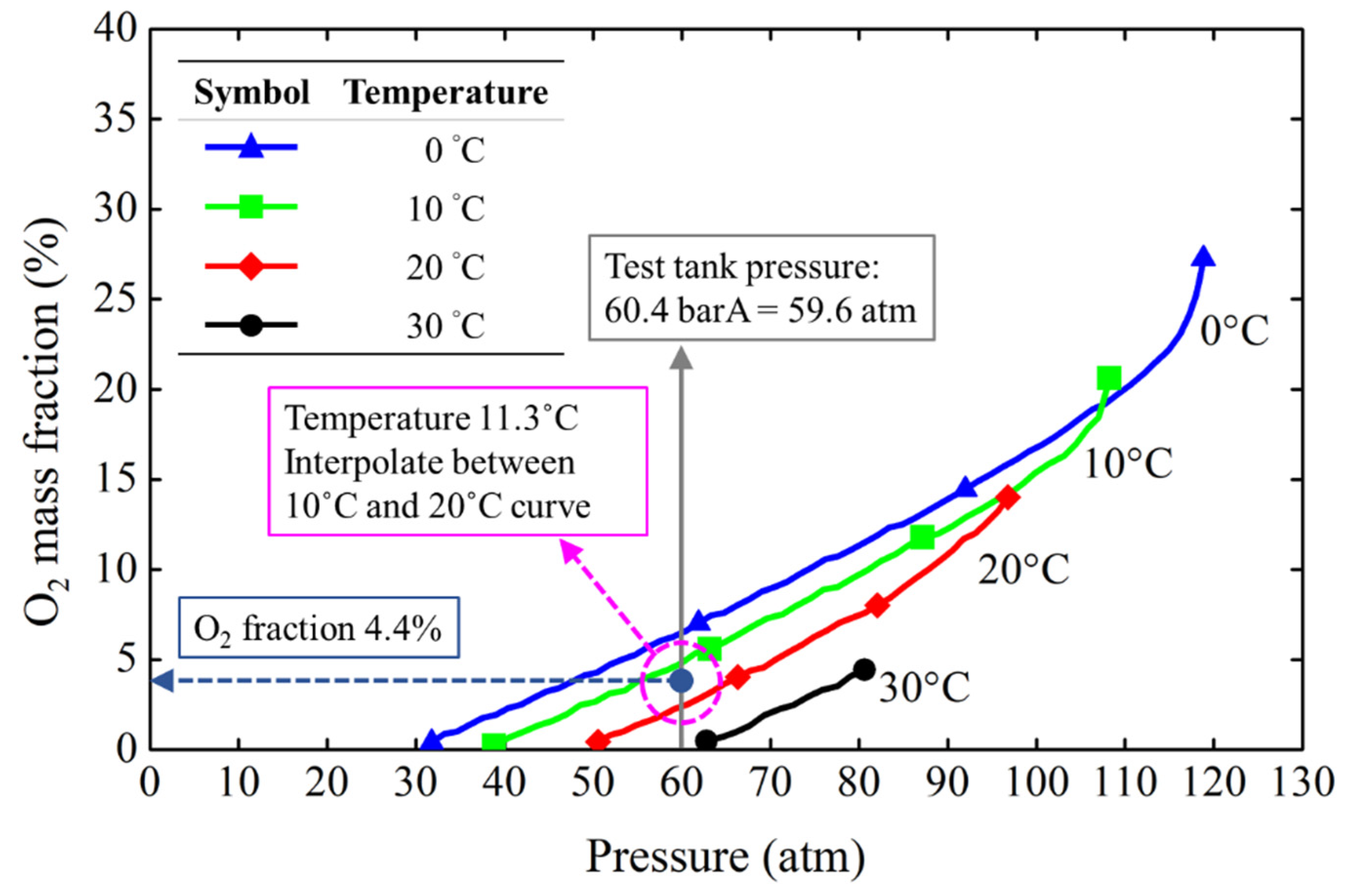
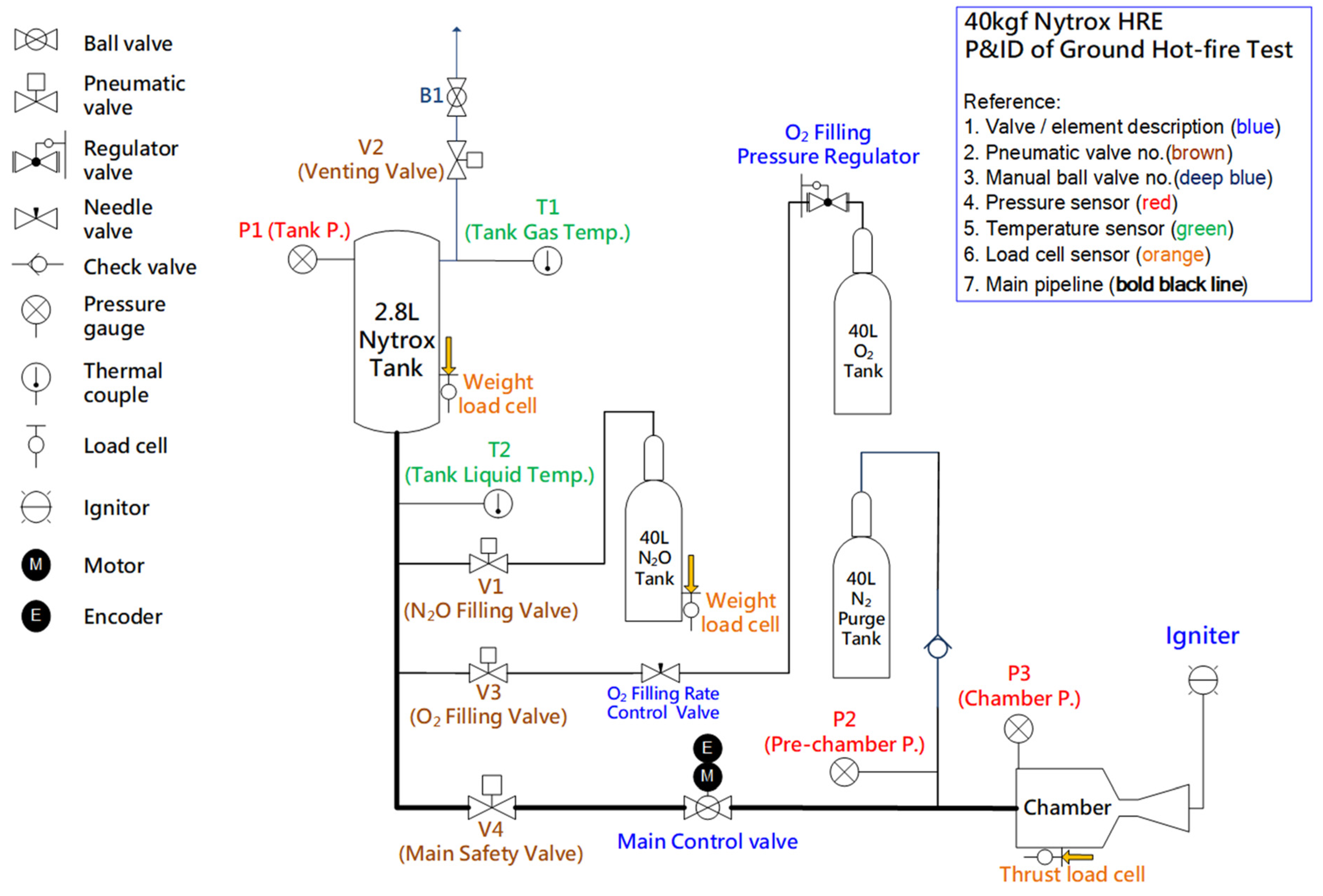



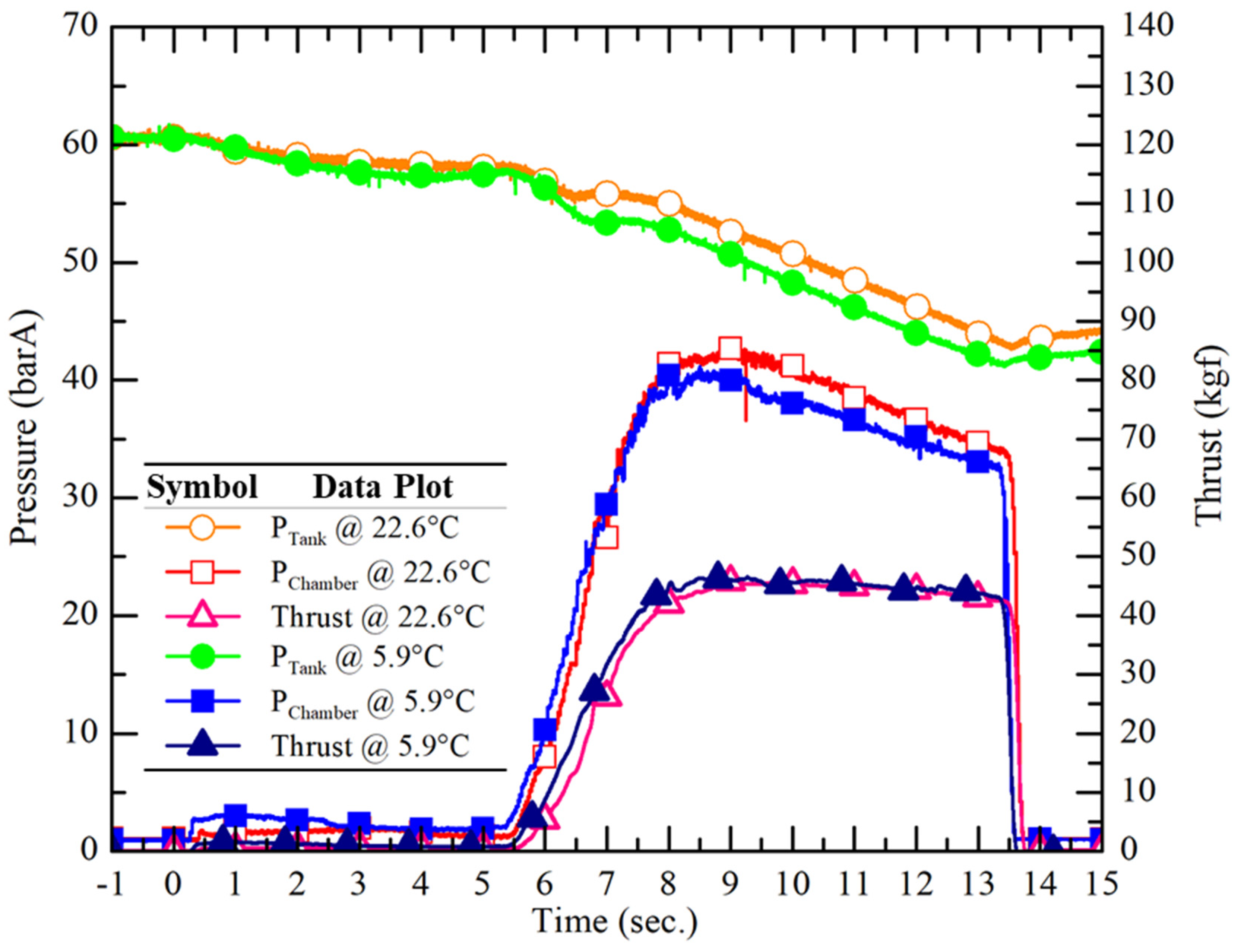

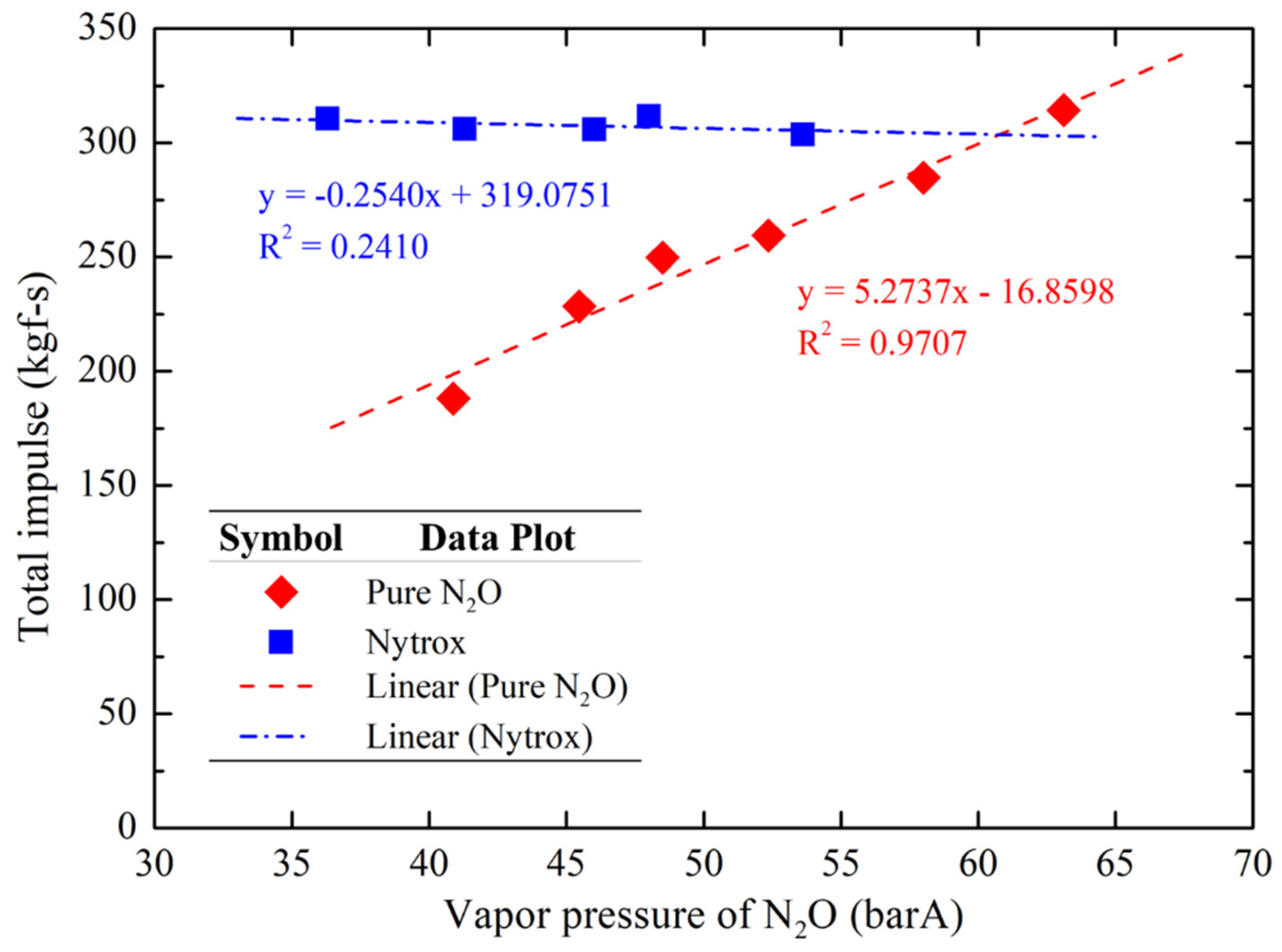
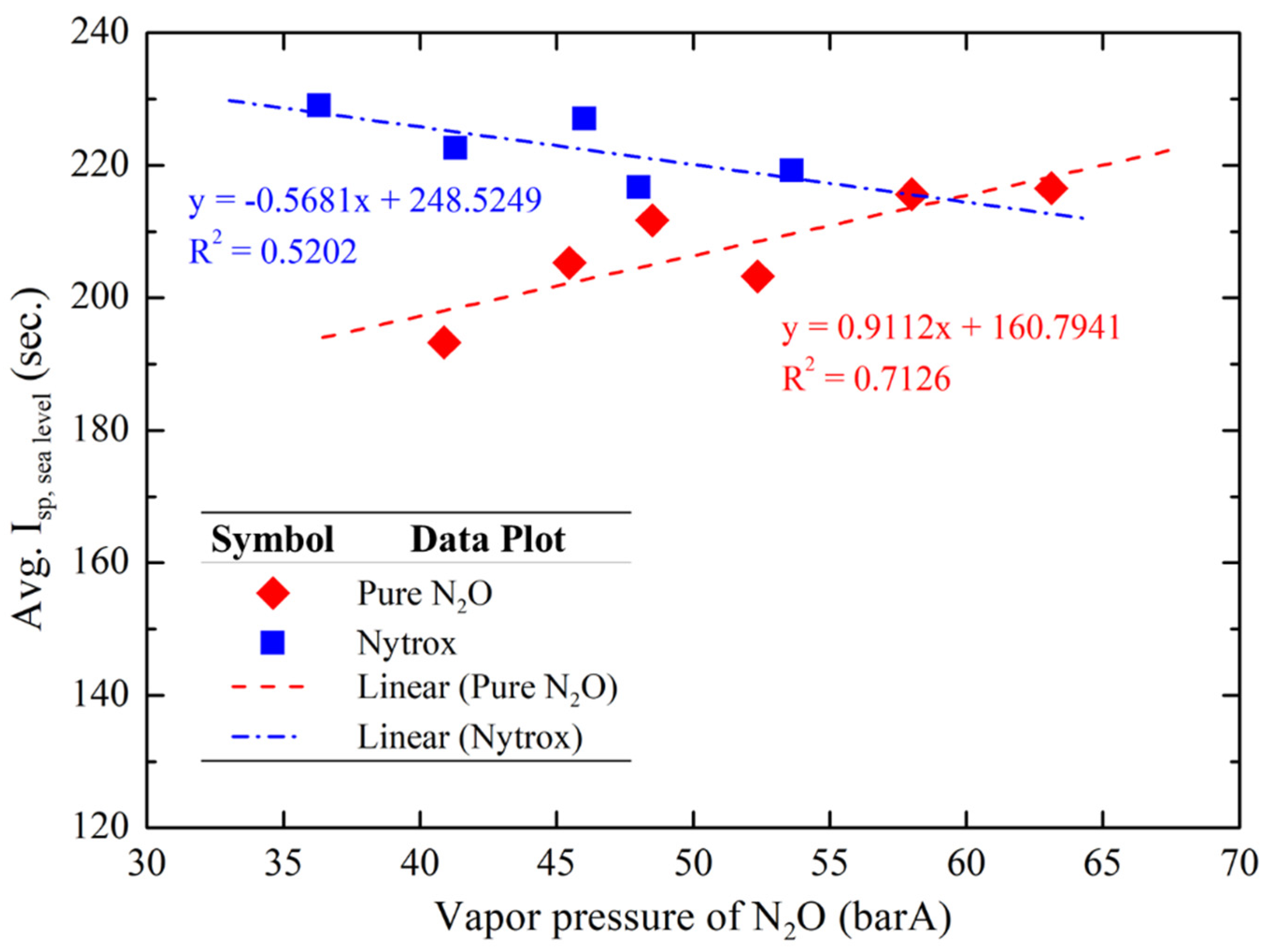
| Temperature (°C) | Vapor Pressure (barA) | Liquid Density (kg/m3) | Vapor Density (kg/m3) |
|---|---|---|---|
| −20 | 18.01 | 995.4 | 46.82 |
| −15 | 20.83 | 975.2 | 54.47 |
| −10 | 23.97 | 953.9 | 63.21 |
| −5 | 27.44 | 931.4 | 73.26 |
| 0 | 31.27 | 907.4 | 84.86 |
| 5 | 35.47 | 881.6 | 98.41 |
| 10 | 40.07 | 853.5 | 114.5 |
| 15 | 45.10 | 822.2 | 133.9 |
| 20 | 50.60 | 786.6 | 158.1 |
| 25 | 56.60 | 743.9 | 190.0 |
| 30 | 63.15 | 688.0 | 236.7 |
| 35 | 70.33 | 589.4 | 300.4 |
| Tcrit (36.42 °C) | 72.51 | 452.0 | 452.0 |
| Parameter | Value | Unit |
|---|---|---|
| N | 16 | - |
| 0.5 | mm | |
| 15 | mm | |
| 70.8 | ° | |
| 60 | ° | |
| 18 | mm | |
| 15.9 | mm | |
| SNg | 58.5 | - |
| N2Ovapor pressure (barA) | 40.9 | 45.5 | 48.5 | 52.4 | 58.0 | 63.1 |
| Tank pressure before test (barA) | 40.9 | 45.5 | 48.5 | 52.4 | 58.0 | 63.1 |
| Avg. chamber pressure (barA) | 26.2 | 31.7 | 34.1 | 35.5 | 38.3 | 41.6 |
| Total impulse (kgf·s) | 188.1 | 228.4 | 249.8 | 259.5 | 284.8 | 314.3 |
| Avg. thrust (kgf) | 26.7 | 33.8 | 35.9 | 38.5 | 43.6 | 45.0 |
| Avg. Isp at sea level (s) | 193.3 | 205.3 | 211.7 | 203.2 | 215.6 | 216.5 |
| Liquid N2O temperature (°C) | 10.8 | 14.9 | 18.1 | 21.5 | 26.3 | 29.8 |
| N2Ovapor pressure (barA) | 36.3 | 41.3 | 46.0 | 48.0 | 53.6 |
| Tank pressure before test (barA) | 60.6 | 60.4 | 60.0 | 60.8 | 60.6 |
| Avg. chamber pressure (barA) | 37.3 | 38.4 | 37.8 | 37.1 | 38.8 |
| Total impulse (kgf·s) | 310.7 | 306.2 | 305.9 | 311.7 | 303.7 |
| Avg. thrust (kgf) | 45.3 | 45.1 | 45.7 | 45.6 | 44.6 |
| Avg. Isp at sea level (s) | 229.1 | 222.6 | 227.1 | 216.7 | 219.2 |
| Liquid N2O temperature (°C) | 5.9 | 11.3 | 15.9 | 18.3 | 22.6 |
| Dissolved O2 mass fraction of Nytrox (%) | 2.9 | 2.7 | 2.6 | 2.2 | 1.2 |
Disclaimer/Publisher’s Note: The statements, opinions and data contained in all publications are solely those of the individual author(s) and contributor(s) and not of MDPI and/or the editor(s). MDPI and/or the editor(s) disclaim responsibility for any injury to people or property resulting from any ideas, methods, instructions or products referred to in the content. |
© 2025 by the authors. Licensee MDPI, Basel, Switzerland. This article is an open access article distributed under the terms and conditions of the Creative Commons Attribution (CC BY) license (https://creativecommons.org/licenses/by/4.0/).
Share and Cite
Wei, S.-S.; Hsu, J.-C.; Tso, H.-Y.; Wu, J.-S. Investigation of Performance Stability of a Nytrox Hybrid Rocket Propulsion System. Aerospace 2025, 12, 372. https://doi.org/10.3390/aerospace12050372
Wei S-S, Hsu J-C, Tso H-Y, Wu J-S. Investigation of Performance Stability of a Nytrox Hybrid Rocket Propulsion System. Aerospace. 2025; 12(5):372. https://doi.org/10.3390/aerospace12050372
Chicago/Turabian StyleWei, Shih-Sin, Jui-Cheng Hsu, Hsi-Yu Tso, and Jong-Shinn Wu. 2025. "Investigation of Performance Stability of a Nytrox Hybrid Rocket Propulsion System" Aerospace 12, no. 5: 372. https://doi.org/10.3390/aerospace12050372
APA StyleWei, S.-S., Hsu, J.-C., Tso, H.-Y., & Wu, J.-S. (2025). Investigation of Performance Stability of a Nytrox Hybrid Rocket Propulsion System. Aerospace, 12(5), 372. https://doi.org/10.3390/aerospace12050372










